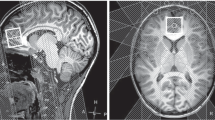Abstract
Creatine kinase reaction rates were measured by magnetisation transfer technique in the brain of healthy adult and aged rats and in the rats with mild or severe chronic cerebral ischemia. These measurements indicated that the rate constant of the creatine kinase reaction is significantly reduced in the case of chronic brain ischemia in aged rats. In contrast, occlusion of both carotid arteries in adult rats produced a slight increase in the reaction rate 4 weeks after occlusion. At the same time, corresponding conventional phosphorus magnetic resonance spectra showed negligible changes in signal intensities.
Similar content being viewed by others
References
Nunnally RL, Hollis DP. Adenosine triphosphate compartmentation in living hearts: a phosphorus nuclear magnetic resonance saturation transfer study. Biochemistry 1979; 18: 3642–6.
Matthews PM, Bland JL, Gadian DG, Radda GK. A31P-NMR saturation transfer study of the regulation of creatine kinase in rat heart. Biochim. Biophys Acta 1982; 721: 312–20.
Clark JF, Dillon PF. Phosphocreatine and creatine kinase in energetic metabolism of porcine carotid artery. J Vasc Res 1995; 32: 24–30.
Spencer RG, Buttrick PM, Ingwall JS. Function and bioenergetics in isolated perfused trained rat hearts. Am J Physiol 1997: 272: H409–17.
Joubert F, Hoerter JA. Magnetization transfer study of creatine kinase in myocardium. Potential clinical interest of in vivo enzymology. Cell Mol Biol 1997; 43: 763–72.
Gadian DG, Radda GK, Brown TR, Chance EM, Dawson MJ, Wilkie DR. The activity of creatine kinase in frog skeletal muscle studied by saturation transfer nuclear magnetic resonance. Biochem J 1981; 194: 215–28.
Horska A, Spencer RG. Measurement of spin-lattice relaxation times and kinetic rate constants in rat muscle using progressive partial saturation and steady-state saturation transfer. Magn Reson Med 1996; 36: 233–40.
Shoubridge EA, Briggs RW, Radda GK.31P NMR saturation transfer measurements of the steady state rates of creatine kinase and ATP synthase in the rat brain. FEBS Lett 1982; 140: 288–92.
Sauter A, Rudin M. Determination of creatine kinase kinetic parameters in rat brain by NMR magnetization transfer. J Biol Chem 1993; 682: 13166–71.
Sharkey SW, Elspberger KJ, Murakami M, Apple FS. Canine myocardial creatine kinase isoenzyme response to coronary occlusion. Am J Physiol 1989; 256: 501–14.
Nascimben L, Friedrich J, Liao RL, Paulleto P, Pessina AC, Ingwall JS. Enalapril treatment increased cardiac performance and energy reserve via creatine kinase reaction in myocardium of Syrian myopathic hamsters with advanced heart failure. Circulation 1995; 91: 1824–33.
Popovich BK, Boheler KR, Dillmann WH. Diabetes decreases creatine kinase activity and mRNA level in the rat heart. Am J Physiol 1989; 257: E573-E577.
Ingwall JS, Atkinson DE, Clarke K, Fettres JK. Energetics correlate of cardiac failure: changes in the creatine kinase system in the failing myocardium. Eur Heart J 1990; 11 (Suppl.) B: 108–115.
de la Torre JC, Butler K, Kozlowski P, Fortin T, Saunders JK. Correlates between nuclear magnetic resonance spectroscopy, diffusion weighted imaging, and CA1 morphometry following chronic brain ischemia. J Neurol Res 1995; 41: 238–245.
de la Torre JC, Fortin T. A chronic physiological rat model of dementia. Behav Brain Res 1994; 63: 35–40.
Morris GA, Freeman R. Selective excitation in Fourier transform nuclear magnetic resonance. J Magn Reson 1978; 29: 433–62.
Clark JF, Harris GI, Dillon PF. Multisite saturation transfer using DANTE and continuous wave. Magn Res Med 1991; 17: 274–8.
Forsen F, Hoffman RA. Study of moderately rapid chemical exchange reactions by means of nuclear magnetic double resonance. J Chem Phys 1963; 39: 2892–901.
Bittl JA, DeLayre J, Ingwall JS. Rate equation for creatine kinase predicts the in vivo reaction velocity:31P-NMR surface coil studies in brain, heart and skeletal muscle of the living rat. Biochemistry 1987; 26: 6083–90.
Smith CD, Landrum W, Carney JM, Landfield PW, Avison MJ. Brain creatine kinase with aging in F-344 rats: analysis by saturation transfer magnetic resonance spectroscopy. Neurobiol Aging 1997; 18: 617–22.
Author information
Authors and Affiliations
Corresponding author
Rights and permissions
About this article
Cite this article
Mlynárik, V., Kašparová, S., Liptaj, T. et al. Creatine kinase reaction rates in rat brain during chronic ischemia. MAGMA 7, 162–165 (1998). https://doi.org/10.1007/BF02591333
Received:
Accepted:
Issue Date:
DOI: https://doi.org/10.1007/BF02591333




